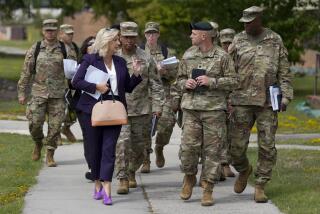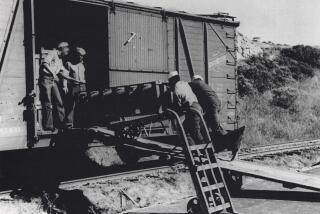Separation of Families Hurts Navy Retention
- Share via
WASHINGTON — Early this afternoon, wives and children of sailors aboard the Coral Sea will crowd onto Pier 12 North at the Norfolk Naval Base in Virginia to catch their first glimpse of the massive aircraft carrier since it sailed for the Mediterranean on Oct. 2.
The Coral Sea, its mission extended from six months to nearly eight by an outbreak of Middle East terrorism, will bring home 5,750 sailors who challenged Moammar Kadafi’s claim to the Gulf of Sidra and launched a dramatic nighttime bombing raid on Libya.
The fliers who made that raid returned home Sunday, winging in ahead of their ship to bases in Virginia Beach and Norfolk, Va., Jacksonville, Fla., and El Toro, Calif.
Gone for Six Months
But beyond its crew, the Coral Sea’s return will bring home a growing problem for the Navy: How, in an era when the husband is taking a more prominent role in child-raising and other family activities, can it persuade men to stay in the service when they must regularly leave home for upward of six months at a time?
“These aren’t the old days,” said Rep. Duncan L. Hunter (R-Coronado), whose district includes the sprawling naval air station at North Island and several other Navy installations. “Maybe the six-month separation is going to be too much for modern Americans.”
Navy Secretary John F. Lehman Jr. said that pressure from home increasingly has become a factor in his efforts to find enough sailors for the 600-ship Navy he is trying to build. “We’ve definitely seen the effect of this in the last five years,” he said in an interview. “Wives are not as easily adapted to the situation because there are so many more working wives.”
To ease the Navy’s burden on family men, Lehman is trying to hold down the length of time ships are at sea. But the Navy’s growing global commitments, which mount every time the United States takes on a new foe like Kadafi, come first, ahead of the family lives of the sailors.
As a consequence, said Vice Adm. Dudley L. Carlson, deputy chief of naval operations for manpower, personnel and training, the No. 1 reason for leaving the Navy “is without a doubt family separation.”
Low Retention Rates
And sailors are leaving the Navy at a growing pace. The retention rate for enlisted Navy personnel completing their first tours, which run from three to six years, declined from 58% in 1984 to an expected 55.5% this year. Retention rates for officers range as low as 39% for those serving on nuclear-powered surface ships.
High turnover means an inexperienced Navy--and it costs money besides. The Navy spends about $1 million to train each pilot and only about 48% of the pilots whose tours end this year are expected to sign up for a new hitch.
To encourage re-enlistment, Congress has given the Navy a $124-million fund to pay for bonuses as large as $30,000 for highly trained specialists in short-handed positions such as nuclear technicians and cryptologists.
And the Navy makes special efforts for its family men. For families who are left behind when sailors are deployed, the Navy’s family assistance program offers services ranging from home repair to psychological counseling. For returning sailors, counselors and psychologists are flown overseas to prepare them to rejoin families in which the wives have been playing the central role.
‘It’s Traumatic’
“She’s been calling all the shots,” said Cmdr. Harry Allen, director of family services at the Jacksonville, Fla., Naval Air Station. “All of a sudden, the husband comes back and he wants to be in control. It’s traumatic. It’s a real issue.”
Unlike most assignments in the Army, Marine Corps or Air Force, a career in the Navy inevitably means separation from family members for long periods. “If you’re going to do well, you go to sea,” said a Navy officer who asked not to be identified. “And if you go to sea, you’re going to have family separations.”
This was not always true. In the 1930s, said Robert W. Nolan, national executive secretary of the Fleet Reserve Assn., a private organization that serves as an unofficial ombudsman for the Navy’s enlisted personnel, “you didn’t have long deployments. You didn’t have the money to get the ships underway. You didn’t have the worldwide commitments and treaties that World War II brought.”
It is only since World War II that long deployments have become a matter of Navy routine, Nolan said. Now, during a normal three-year tour, a sailor can expect to be deployed on two six-month trips. Sailors commonly are at sea when their first child is born or takes his first steps or spends his first year at school.
86,000 Single Parents
“Each day the Navy has the equivalent of 86,000 single parents while their spouses are at sea,” Carlson told a House Armed Services subcommittee last month.
And even during a sailor’s two years at home, frequent two-week training cruises mean that he probably will spend half of that time at sea as well. The aircraft carrier Saratoga, which returned to Mayport, Fla., last month after an eight-month cruise to the Mediterranean, spent only 56 nights at its home port in the preceding 12 months.
Training cruises prove particularly frustrating for the crews of ships assigned to San Diego, which frequently steam out of port for two weeks that are spent barely beyond the harbor and often short of the horizon--out of touch with the folks at home but barely out of sight.
Separation may have less of an impact on Navy families than it has on others. Rosanna Hertz, a sociologist at Wellesley College in Massachusetts, said that military families “have a more rigid definition of gender roles,” and they are more likely to accept the husband’s absence if necessary to advance his career.
And Capt. R. A. Stratton, commanding officer of the Naval Academy prep school, wrote in the April issue of “Proceedings,” a publication of the U.S. Naval Institute, that “family separation” has become a convenient excuse for sailors who quit the Navy for other reasons--the disruption caused by frequent moves, dissatisfaction with the military bureaucracy or the boredom of an on-shore assignment.
Role of Family Life
But Naomi Gerstel, a University of Massachusetts sociologist who has written about couples living apart from each other, is one scholar who believes that changing family life is playing a role. “I suspect some small number of Navy men are being more responsive to the pressure of responsibilities at home,” she said.
Allison Stinson, a counselor at the Jacksonville base, said she finds Navy wives are more frequently voicing concern that their children miss their fathers when they are gone. Stinson, who is the wife of a senior chief petty officer and the mother of two teen-age daughters, said that her husband has taken on greater responsibilities at home.
When he was at sea recently, she said, “it put a real strain on our family. There were years ago when that would never have been the case.”
A helicopter pilot with two teen-age children insisted that, despite his five extended deployments during his 17 years in the Navy, “I don’t think I’m neglecting my children.”
But he has paid a price. The officer, who could not be named under Navy security ground rules because he had served aboard the Saratoga during its Middle East deployment, received a three-day leave when his daughter was born but missed the birth of his son.
“He wasn’t really involved,” his wife said. “These kinds of experiences I definitely have deep regrets about. Not resentment, but regret. He has missed that.”
Carlson said the problem of finding able-bodied sailors “has been with navies since the beginning of man.”
“They used to shanghai sailors,” he said, referring to the 19th Century practice of drugging young men and dragging them aboard merchant marine ships. “We have better techniques now.”
1970s Shortage
One of them is limiting the time that sailors must spend on the high seas. In the late 1970s, when deployments crept up to 10 months, the Navy faced a shortage of 21,000 petty officers--the noncommissioned officers considered crucial to the operation of a ship. The service tried to entice sailors to stay by offering them bigger re-enlistment bonuses.
“But bonuses didn’t do it,” a Pentagon official recalled. “The root problem was, ‘Daddy was away for 10 months.’ ”
When the carrier Dwight D. Eisenhower returned from an eight-month tour in the Indian Ocean and Arabian Sea during the Iranian hostage crisis, Lehman said, “retention was 25% and morale was at rock bottom.”
Ideal Period of Time
Now the Navy is trying to hold deployments to six months. A spokesman said the Navy has found that to be an ideal period of time: long enough to make efficient use of its ships and provide sufficient training time, but not so long that it chases sailors out of the service.
But the Navy has not always met its goal. The battleship New Jersey left Long Beach in June, 1983, and returned nearly 11 months later after taking part in operations off Central America and Beirut and in exercises near Thailand and the Philippines. It made only three port visits during a 76,000-mile voyage.
The Coral Sea, assigned with the Saratoga and the America to Mediterranean duty as part of the U.S. 6th Fleet, left Norfolk last Oct. 2 and, after seeing action off the coast of Libya, was about to head home on schedule in April when it was given new orders to remain in the area indefinitely. It finally headed west across the Atlantic on May 9 on the final leg of its journey.
“When the Navy went through all the ballyhoo on cutting down deployments, it didn’t count on a little war,” a senior Pentagon official said.
Maybe it should have. From 1946 to 1975, according to a study by Barry M. Blechman and Stephen S. Kaplan that was published by the Brookings Institution, the United States was involved in 215 international incidents in which it used armed forces to accomplish foreign policy objectives. Of these incidents--which exclude such outright combat as the Korean conflict and the Vietnam War--the Navy took part in 177.
Used by Authorities
“We are the force that gets used by the national command authorities,” Carlson said with more than a touch of service pride.
To meet the demands being placed on the Navy, Lehman is overseeing the growth of the fleet from the 479 vessels in service when the Reagan Administration took office to a target of 600 ships.
Roster Grows
And the Navy’s personnel roster, unlike those of the Army, Marine Corps and Air Force, has been growing in recent years, from 571,000 last year to the current 581,000 and an expected 593,000 next year, despite the budget-cutting pressures that are being felt by nearly all military programs.
Beyond trying to limit deployments, the Navy has established its family assistance program in recognition of the hardships faced by Navy families. Newsletters periodically inform those at home about ships’ progress overseas and about assistance available to sailors’ families. An ombudsman--the wife of a crew member--is appointed to carry the questions and complaints of family members to the Navy and to offer emotional support and guidance to families.
Emergency Services
“The first week I was gone, the refrigerator died, there were two flat tires on the car and something went wrong with the plumbing,” said a Navy lieutenant assigned to the Saratoga. For such emergencies, more than 60 family service centers at Navy bases around the country offer a free handyman service in which off-duty sailors and officers volunteer their time to make household repairs in place of husbands who are at sea.
The Navy has come a long way. Only a generation ago, said Lt. Lee Braddock, an administrative officer at the Jacksonville Naval Air Station, family assistance meant little more than a pre-deployment briefing for wives in which an officer warned that as a result of combat, “some of your husbands won’t come home.”
“In the last couple of years, it’s like the Navy just discovered there are sailors out there getting married,” said Nolan, the retired chief petty officer. “When I was in the Navy, there was a saying that if the Navy wanted you to have a wife, they’d have issued you one.”
KEEPING THEM IN THE NAVY Percentage of enlisted men who re-enlisted during or after their first three tours, which typically last from three to six years each, and officers who remained in the service after completing their initial obligation, which ranges from four to seven years.
1983 1984 1985 1986* Enlisted men First tour 56% 58% 55% 55% Second tour 65 64 64 65 Third tour 97 95 93 94 Officers Surface ships 45 50 47 47 Nuclear surface ships 45 42 39 39 Pilots 58 56 53 48 Other aviation specialists 74 81 73 74 Nuclear Submarines 46 47 48 48 Others 60 59 64 63
*planned (enlisted men) or projected (officers) Source: U.S. Navy
More to Read
Sign up for Essential California
The most important California stories and recommendations in your inbox every morning.
You may occasionally receive promotional content from the Los Angeles Times.













